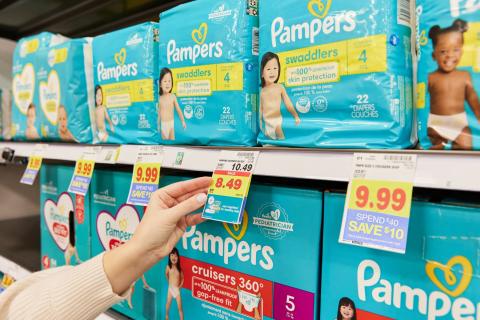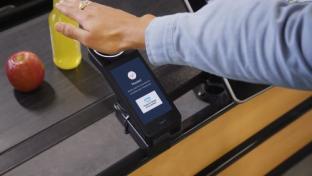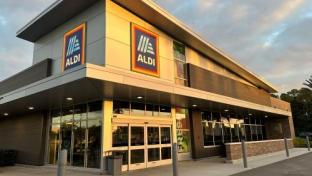Converting Browsers Into Buyers With Shelf-Edge Solutions

Shelf-edge and related technologies are rapidly evolving, becoming less costly and more capable while providing options that allow grocers and other retailers choices in how they want to invest for the maximum benefit.
Samsung, for one, is working with retailers to get them onboard with in-store digital technologies, applying its knowledge of video, networks and software to support applications that can satisfy multiple goals, from reducing labor to supporting promotions. It no longer makes electronic shelf labels (ESLs), but it works with companies that produce them and uses its own expertise to give grocers access to what shelf-edge technology can do for them, whether they want to initiate a program, upgrade an existing one, or explore new opportunities such as in-store advertising, a capability that Samsung supports.
[Read more: "What's New in Supermarket Shelf Technology"]
Parrish Chapman, senior director, enterprise retail sales, key accounts at Samsung Electronics America, in Ridgefield Park, N.J., describes the opportunity that grocers have when it comes to shelf-edge technology as “massive,” given the store traffic that such initiatives can reach.
The potential of in-store digital selling is becoming increasingly evident, and grocers that have become more involved in omnichannel operations have recognized the advantages available if they can interact with customers in stores as they do online. However, many grocers have yet to begin, or are only somewhat involved in, up-to-date shelf-edge technology.
According to Chapman, Samsung is not only helping grocers that are already sophisticated in their use of in-store technology, but also those who are taking their first steps. One way the company does so is by helping them look at a store in a compartmentalized fashion, building on the different ways that consumers shop and that retailers present goods across different departments.
Focusing Investments
Although ESLs that can be automatically updated get a lot of attention, many grocers that are interested in shelf-edge tech investments shy away from a commitment to — and the cost of — ESLs early on. Chapman says that these grocers generally favor smaller investments in screens that focus more on product information and messaging, and then look at return on investment. Samsung works with customers to focus investments where there are better opportunities to drive business, bringing its expertise with content to bear in that effort.
“You can divide the store up into shops-within-a-shop, and let’s say we talk about the candy aisle,” he notes. “We can create a whole digital experience for the candy aisle that is amazing. We know, with this technology, if the traffic goes up or down, if dwell time is increasing, and if you stay longer, you buy more.”
Shelf edge isn’t just about optimizing price and promotion, although that can and should be a key consideration in a store-based digital effort. A narrow focus on price will become less effective over time if unsupported by feature displays that handle other kinds of messaging. ESLs that are more capable than those narrowly displaying price, including those with squared configurations or that add bibs containing additional information, can provide support. The opportunity is to offer content and even shopping support to consumers in-store that encourages interaction and, as a consequence, more purchasing. Samsung is working with and even developing software to give grocers advantages that are consistent with their operations. For example, it’s sourcing sophisticated weather data and applying it in the food retailing case.
“We’re doing forecasting; we’re doing weather triggers and alerts on weather,” affirms Chapman. “Weather is becoming this issue in America, and we want to use it to build branding. So [in] all our launches now, we’re including weather as an intellectual product to capture people’s attention.”
He adds: “Most CEOs say we need to get 15% sales growth. What we tell our clients is: ‘Where are we going to focus that in stores? Where do you want it to come from?’ That’s where this content is so important. You have to have a balanced content approach. We’re talking about the proper location, and you provide something that’s fun and informative and interactive.”

Getting Started
Shelf-edge technology programs can start with the use of dedicated tags that convey information relevant to where they’re placed, whether as an element on an ESL or even a paper tag, or a tablet screen on an end cap. In one example, a store could put in several small shelf-mounted screens that focus attention on a range of content, including product information, deals, loyalty program features, and even social media, which, if properly deployed, can keep the conversation started in-store going when the consumer is outside the store.
By starting with more informational displays, including larger screens on end caps and split screens meant to include informational and pricing presentations for a particular section, grocers can see the value and get a sense of what the investment return is on shelf-edge and associated technology. It’s then that consideration of ESLs can become more attractive. Beyond marketing and pricing, in-store digital technology can include branding content and feel-good messaging meant as much for employees as for customers, and which can even help with retention.
Thereafter, monetization becomes part of the discussion. According to Chapman, going in with monetization as the first priority isn’t the best way to get involved with shelf-edge technology if a grocer is going to get the maximum benefit. Samsung can help with the network it developed, however.
A Different Perspective
Based in Preston, Victoria, in Australia, In2Digital is a strategy and advisory firm that works on shelf-edge technology, including Samsung display systems.
Founder and CEO Francesca Surace says that supermarkets and other retailers in the markets in which In2Digital engages are placing more emphasis on productivity, and that becomes an inducement to working with internet-linked ESLs and other digital signage that require little human interaction.
Supermarkets and other retailers “are placing a greater emphasis on productivity benefits, which involves reducing the number of floor staff required to perform traditional, labor-intensive labeling updates,” she notes. “Some retailers are investigating the potential wider business benefits that come with full back-end integration, such as linking in-store digital signage and an event-driven IoT [Internet of Things] ecosystem.”
According to Surace, digital signage offers different retailers opportunities in tune with their operations.
“High-end fashion stores may use larger ESLs and digital shelf-edge displays that showcase more marketing information, while fresh food stores may use larger ESLs to display nutrition information,” she says. “The ESL market offers a variety of label options to cater to diverse use cases, from simple grocery stores to mobile phone shops that use NFC tap for more product information or back-end stock displays. These technologies are flexible and valuable tools for businesses.”
Although some retailers look at shelf-edge technology in a limited way right now, especially for productivity gains, grocers and other store runners can take a broader view across a much wider range of opportunities when devices such as ESLs are combined with other advancing tech.
“With integration in back-end software and IOT, coupled with the emerging capability of AI, we can expect to see significant advances in the use case of these technologies and solutions,” predicts Surace. “Key areas include dynamic pricing using AI to automatically gather competitive pricing and recommend price changes, and personalized promotion that can be displayed on ESLs, providing customers with personalized deals and recommendations as they walk through the store.”
Shelf-edge technology can also couple with inventory management using AI-powered algorithms to predict product demand and inventory levels more accurately, thereby reducing instances of out-of-stocks and overstocks. In terms of data, retailers can use AI to analyze customer demographics and shopping behaviors, and display location-specific advertisements on ESLs. In doing so, they can help promote products that are relevant to local customers. Shelf-edge technology can also support in-store navigation systems that guide customers to specific products using interactive maps displayed on ESLs.

Consistent Results
Matt Pavich, senior director of strategy and innovation at Alpharetta, Ga.-based Revionics, a pricing optimization solutions provider for retailers, notes that ESLs today have a solid business case behind them as technology and the market have evolved in areas such as price optimization. Even the hardware itself has become more formidable, with longer battery life that can keep an individual ESL working for eight years and sometimes 10.
[Read more: "Using Advanced Technology to Drive Pricing Decisions"]
However, pricing optimization and promotion, combined with shelf-edge technology, can provide substantial returns. According to Pavich, well-managed price optimization and promotion have allowed Revionics customers to outperform the market, gain share and even grab customers from rivals. Pricing optimization strategies using AI to gather relevant data provide grocers and other retailers a better understanding of what prices and discounts have the maximum effect in different locations. They can even save retailers money by demonstrating how deep a discount is enough to generate the sales wanted. Because the use of tools such as price optimization is based on exacting science, grocers can get consistent results and even venture into predictive analysis to deal with situations on the horizon.
“When you talk about pricing optimization, you become more efficient [and] you become more effective promotionally,” says Pavich.
He makes the point that price optimization backed by AI has been around for quite a while, powering the constant price changes that are commonplace in e-commerce. Given the familiarity that today’s grocers have with omnichannel strategy, more executives than ever are eager to apply these types of solutions in stores, as they already do digitally. As its integration in physical stores becomes more sophisticated, personalization becomes part of the equation. Stores won’t be changing prices for individual customers, but a loyalty app can direct them to the promotions that are most relevant to them.
The combination of shelf-edge technology and price optimization can have a dramatic effect in-store. Labor savings on price changes is an immediate result, given that retailers can now change an ESL automatically. Not only does it enable an employee to go from working on shelves to working with customers, it also eliminates concern about how many price changes can be made in a day, given the available labor.
Paper Trail
Still, if ESLs get a lot of attention, many grocers have tapped solutions that don’t require investment in individual ESLs but deliver many of their benefits if consistently applied.
Ryan Yost, VP general manager at Avery Dennison, in Mentor, Ohio, estimates that 95% of the work that he does in shelf-edge technology, including with the company’s Vestcom business, involves paper, with just 5% involving ESL. He contends that grocers don’t need to rely on any single shelf-edge technology. In situations with highly promotional goods or those otherwise subject to frequent price changes, ESL may be ideal. Still, for products that typically have only a few regular price changes over the course of a year, the investment might not be worth it.
Paper tags such as the ones Avery Dennison offers, which don’t just offer price, but also have space for messaging, may make more sense for product categories where pricing is consistent. What’s more, the labels are easy to mount and come in a stack that’s subject to an automated process in printing, so that each is sequenced. An employee with a stack of tags can start at the beginning of the first aisle and proceed along the shelf directly, as the tags correspond to the order of products as merchandised. The result is significant labor savings as opposed to the old way of doing things that had employees hunting around the store to find the right place to mount a tag.
The labels also include space for promotional messages and other means of reaching out to the shopper. Messaging can let the consumer know that an item is new, what other products might be purchased in combination with it to assemble meals, and how the company behind the item is addressing social issues, and it can also link to social media accounts and posts.
Yost suggests that three elements should be in place to maximize the potential of shelf-edge technology: labor efficiency, sales uplift, and customer engagement as a means of building loyalty. Today, more capable ESLs, advanced paper tags, and video displays on end caps and even on cold- case doors can be combined as appropriate to provide grocers with positive results on the cost and sales side. Some emerging benefits that shelf-edge technology can provide include the ability to locate where a consumer is on the floor, what their preferences tend to be and what promotions they might consider. Privacy considerations have to be addressed, but when marketers have the ability to offer the consistent purchaser of granola who hasn’t bought any in a while a coupon while that shopper is passing the cereal display, more of the potential of shelf-edge technology will be achieved.






